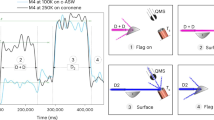Abstract
KRASOVSKII1 has suggested that the presence of ion-clusters of hydrogen in gaseous nebulae could account for the absorption and polarization of stellar radiation. It has since been argued2 that interstellar gas densities are too low for such processes. Hoyle and co-workers3,4 have, however, proposed that condensation of hydrogen on graphite grains at ∼3 K might promote the formation of galaxies and stars. The densities of hydrogen in interstellar clouds may thus be great enough for ion-clusters to form by interaction with radiation.
Similar content being viewed by others
References
Krasovskii, V. I., Sov. Astron., 2, 775 (1958).
Donn, B., Astrophys. J., 132, 507 (1960).
Wickramasinghe, N. C., and Reddish, V. C., Nature, 218, 661 (1968).
Hoyle, F., Wickramasinghe, N. C., and Reddish, V. C., Nature, 218, 112 (1968).
Cramer, W. H., J. Chem. Phys., 35, 836 (1961).
Loeb, L. B., Basic Processes of Gaseous Electronics, 545 (Univ. of California Press, Berkeley, 1961).
Bloom, S., and Margenau, H., Phys. Rev., 85, 670 (1952).
Author information
Authors and Affiliations
Rights and permissions
About this article
Cite this article
CLAMPITT, R., GOWLAND, L. Clustering of Cold Hydrogen Gas on Protons. Nature 223, 815–816 (1969). https://doi.org/10.1038/223815a0
Received:
Issue Date:
DOI: https://doi.org/10.1038/223815a0
- Springer Nature Limited
This article is cited by
-
On the topology of the electron density of H 3 + ${\mathrm {H}}_{3}^{+}$
Structural Chemistry (2017)
-
Experimental study of the dissociation of 100?600 keV hydrogen cluster ions in an argon gas target
Zeitschrift f�r Physik D Atoms, Molecules and Clusters (1986)
-
Near-Hartree-Fock energies and geometries of the hydrogen clusters H n + (n(odd) ? 13) obtained with floating basis sets
Theoretica Chimica Acta (1983)
-
Ejection of positive cluster ions from large electron-bombarded3He or4He clusters
Journal of Low Temperature Physics (1981)
-
Odd and even numbered hydrogen ion clusters
Nature (1979)





